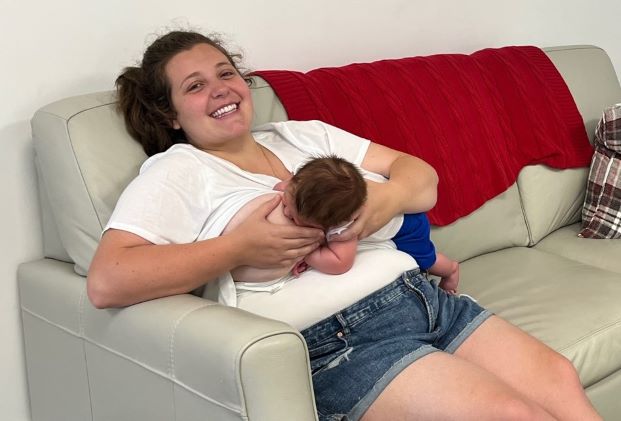“I thought breastfeeding was supposed to be easy”
10 Tips to ENJOYING your breastfeeding experience

“I thought this just happened naturally”.
I hear these sentiments time and time again in the Infant Feeding clinic at The WOMB where I work as as an International Board Certified Lactation Consultant. In a society that has instant access to information, to ALL information, we know what is best for our babies. Google, Best Start, Baby Centre – the message bombards us everywhere: BREAST IS BEST. Yes, we know, we know!
So what if breastfeeding is challenging to the point of wanting to give up? What do we do when the pressure to live up to this expectation to breastfeed makes us feel we will “fail as a parent” if we don’t?
BUT, what if you can feel empowered and like a success no matter what your breastfeeding journey – just through support, information and love?
Because I often am told, “I wish I had known these tips before I had my baby” by parents in our Infant Feeding clinic, here are 10 valuable tips that can make your breastfeeding experience more successful and enjoyable.
1) Skin to skin – right after birth and for the first few weeks after baby is born. When your baby is skin to skin with you, your baby will cue to breastfeed more often and you will become familiar with the feeding cues (see below). Breast or chest feeding parents who do skin to skin are much more confident. They are able to understand their baby’s needs and therefore are able to respond quicker.
As a bonus, skin to skin stabilizes baby’s breathing, heart rate and body temperature and reduces stress. Something as simple as hanging out with your baby allows the body to release oxytocin which helps increase milk production and more importantly helps you bond with your baby.
2) Baby and breast or chest feeding parents should not be separated unless medically indicated. There is no need for your baby to be separated from you. Rooming in results in better breastfeeding success for many of the same reasons as above.
3) Nurse your baby frequently – a baby who nurses frequently (at least 8 times in 24 hours) will help you develop a good milk supply. Your baby will also gain weight and avoid things like jaundice and low blood sugar.
Your newborn’s stomach is very small (think of the size of a chickpea) and cannot hold a large amount of milk. So your first milk (called colostrum) will be produced in small amounts chalk full of vitamins and immune factors that protect your baby. Because of that your baby will want to eat quite often (usually every 2-3 hours).
Even if your baby is not interested in latching, knowing how to hand express your colostrum and giving it by hand, cup or spoon will help your baby.
4) Learn your baby’s feeding cues – know the difference between an early feeding cue versus a late feeding cue. This will help you have a more peaceful, joyful feeding experience.
Early cues (“I’m hungry”) include
• stirring
• mouth opening
• licking lips
• turning head and seeking/rooting
Mid cues (“I’m really hungry”) include
• stretching
• increased physical movement
• hand to mouth
Late hunger cues (“you need to calm me and then feed me”) include
• crying
• agitated body movements
• colour turning red
Crying is always a late hunger cue. Catching your baby when they show early feeding cues makes breastfeeding easier for both you and your baby.
5) Watch your baby, not the clock – There should be no restriction on the length or frequency of feedings. Babies eat just like we do. Some feeds will be meals while others may just be a snack. If someone told you that you could only eat or drink every 3 hours and you had to eat the same amount every time, you wouldn’t be too happy, so why should we expect our babies to eat this way? Feeding babies on demand makes for a happy, healthy baby.
6) A good latch and comfortable position – it should never hurt to breastfeed. Please don’t let anyone tell you it’s normal to be in pain or that your nipples have to “get used to it”! If it hurts, something is not right. A good latch makes breastfeeding comfortable for both parent and baby, and ensures good transfer of milk from breast to belly.
A lactation consultant can show you what “transferring” milk looks like while your baby feeds. When transferring milk is not effective, you may notice your baby may never be satisfied and will want to eat all the time. Thus when your breasts are not emptied, feedback is given to your body that there is too much milk not being used and this can cause a decrease in your supply.
There are many breastfeeding positions, so find a position that is comfortable for you. I prefer the Laid Back Breastfeeding or Biological Nurturing position where every part of your body is supported especially your shoulders and neck. You will feel more relaxed and your tension will be reduced. And even better, in this position, most babies will self-attach!
7) Signs your baby is getting enough – this is the #1 question I always get, “how do I know my baby is getting enough to eat?” Weight gain is a good sign that breastfeeding is going well. All babies lose weight after birth and most will regain their birth weight by 2 weeks. Then babies typically gain between 15 to 30 grams/day. But you can tell from day to day if your baby is getting enough by diaper output. What goes in has to come out!! If your baby is having at least 6 wet diapers and frequent bowel movements (1-3/day) then your baby is getting enough.
Other questions to ask yourself: Do your breasts feel softer after a feed? What is your baby’s mood like after a feed? Is your baby content, quiet, sleeping, happy to just play? These answers will tell you that your baby is satisfied.
8) Growth spurts and cluster feeds are normal – your baby will go through certain periods in the first few months when he/she will want to feed more often for a few days. This increased appetite is normal and will not only satisfy your baby’s growing needs but will also increase your supply to meet his/her growing needs.
You may also experience a period in the day when your baby will want to feed more often. This is called cluster feeding and it is normal. It does not mean you have low milk supply.
9) Get help/support – If things are not going well, please seek out help. There are various forms of support available for you. There are peer support groups, support from other breastfeeding parents, friends and family, La Leche League, Public Health and private lactation consultants or Infant Feeding Specialists such as The WOMB. Challenges are easier to fix, if dealt with early but we are ALWAYS here to help you. We welcome you into a safe, loving and supportive environment where you will feel empowered to meet your breastfeeding goals.

10) Enjoy your baby – breastfeeding is about so much more than just feeding your baby. It is a special and intimate relationship that creates a special bond between mother and baby.
Want more information and tips on how to do all this? Get more at a prenatal breastfeeding class! Join us at The WOMB for our next class or visit us in the Infant Feeding Clinic!
 Anita Arora is an International Board Certified Lactation Consultant at The WOMB Milton and sees clients in their homes privately and in clinic. Anita’s aim is to help parents reach their feeding goals in a non-judgmental, accepting and natural approach. Anita lives in Oakville with her supportive husband and her 2 wonderful children.
Anita Arora is an International Board Certified Lactation Consultant at The WOMB Milton and sees clients in their homes privately and in clinic. Anita’s aim is to help parents reach their feeding goals in a non-judgmental, accepting and natural approach. Anita lives in Oakville with her supportive husband and her 2 wonderful children.





